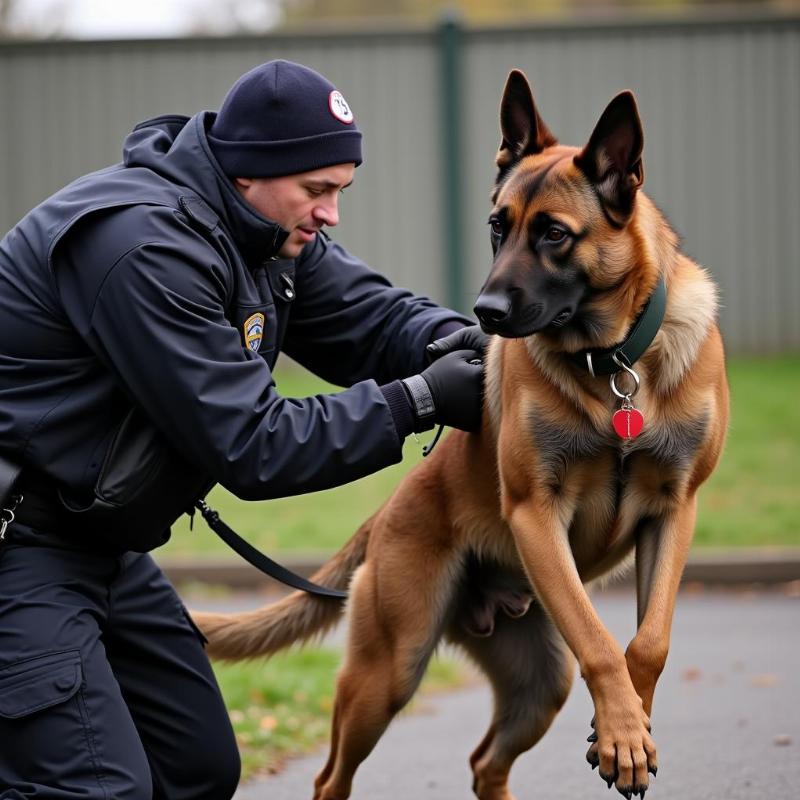Police dogs, often called K9 units, are invaluable partners in law enforcement. Their incredible sense of smell and trainability allow them to perform tasks that humans simply can’t. But how exactly do these four-legged officers know who the “bad guy” is? It’s not magic, but a combination of intensive training, natural instincts, and a handler’s guidance that allows them to distinguish between friend and foe in high-pressure situations.
Decoding the Scent of Suspicion: How K9s Identify Threats
A police dog’s primary tool is its nose. Their olfactory system is significantly more powerful than a human’s, allowing them to detect incredibly faint scents and differentiate between thousands of different odors. This ability is crucial in identifying suspects, locating missing persons, and detecting contraband. While a dog can’t inherently tell right from wrong, their training focuses on associating specific scents with “bad guy” behaviors.
For instance, a dog might be trained to detect the scent of fear or adrenaline, which a fleeing suspect is likely to exude. They can also be trained to identify the scent of specific substances, like explosives or narcotics, further linking a person to criminal activity. The training process involves positive reinforcement, rewarding the dog when it correctly identifies the target scent. This creates a positive association and motivates the dog to perform its duties effectively.
The Handler’s Role: Guiding the Canine Partner
The relationship between a police dog and its handler is essential. The handler acts as the dog’s guide, interpreter, and protector. Through verbal commands and hand signals, the handler directs the dog’s actions and ensures its safety. They also interpret the dog’s behavior, recognizing subtle cues that indicate the dog has located a suspect or detected a specific scent. This partnership requires trust, communication, and a deep understanding of each other’s strengths and limitations.
A handler’s guidance is especially critical in chaotic situations. They can help the dog focus on its task, filtering out distractions and ensuring the dog doesn’t misinterpret a situation. This control prevents accidental apprehensions and ensures the dog’s actions remain within legal boundaries.
Beyond Scent: Other Factors in K9 Identification
While scent plays a significant role, other factors contribute to a police dog’s identification of a suspect. These can include visual cues, like a suspect’s body language or attempts to flee, and the handler’s directions. The dog learns to associate these cues with “bad guy” behavior, further refining its ability to identify threats.
 Police dog apprehending suspect
Police dog apprehending suspect
Specific Training Scenarios: Preparing for Real-World Situations
Police dogs undergo rigorous training for a variety of scenarios, including suspect apprehension, search and rescue, and narcotics detection. This specialized training equips them with the skills and knowledge needed to perform effectively in diverse and often dangerous situations. For example, a dog trained in suspect apprehension learns to use controlled aggression to subdue a suspect without causing unnecessary harm. This involves biting and holding the suspect until the handler can take control.
Addressing Common Misconceptions
There are some misconceptions about how police dogs identify suspects. One common misunderstanding is that they are trained to target specific racial or ethnic groups. This is simply not true. Their training focuses on behavior and scent, not on physical appearance.
Conclusion
Police dogs play a vital role in law enforcement, using their extraordinary sense of smell, intensive training, and close partnership with their handlers to identify and apprehend suspects. While scent is a primary factor, visual cues, handler guidance, and specialized training scenarios also contribute to their effectiveness. By understanding the methods and principles behind K9 work, we can appreciate the dedication and skill of these remarkable canine officers.
FAQ
- Do police dogs always bite suspects? Not always. Police dogs are trained to use controlled aggression and will only bite when necessary to subdue a suspect or protect themselves or their handler.
- How long does it take to train a police dog? Training typically takes several months and involves intensive work on obedience, scent detection, and apprehension techniques.
- What breeds are commonly used as police dogs? Common breeds include German Shepherds, Belgian Malinois, Labrador Retrievers, and Dutch Shepherds, chosen for their intelligence, trainability, and physical capabilities.
- Can police dogs detect multiple types of contraband? Yes, they can be trained to detect various substances, including explosives, narcotics, and even electronic devices.
- What happens to police dogs after they retire? Many retired police dogs are adopted by their handlers or other loving families, allowing them to enjoy a well-deserved rest after years of service.
- Are police dogs aggressive? Police dogs are trained to be assertive when necessary, but they are also well-socialized and capable of being friendly and gentle.
- How accurate are police dogs in identifying suspects? Their highly developed sense of smell and training make them incredibly accurate in detecting scents and identifying individuals associated with those scents.
Beautdogs.us is your premier destination for all things dog-related in the US. We offer expert advice on dog breeds, care, and products, empowering you to be the best pet parent possible. Whether you’re a seasoned dog owner or just starting your journey, Beautdogs.us is your trusted resource. Contact us today to learn more! Email: [email protected], Phone: +1 501-555-7529. Visit Beautdogs.us for expert guidance and a curated selection of top-quality products for your beloved companion.